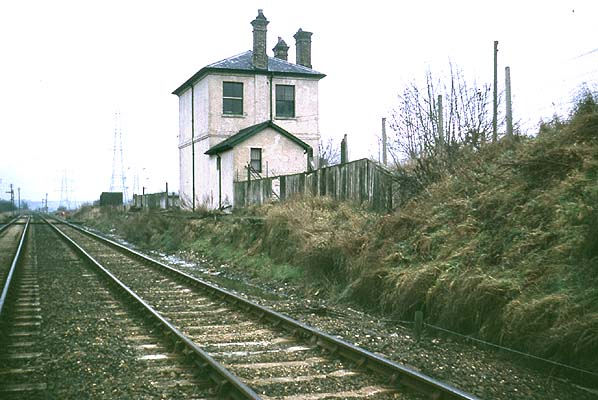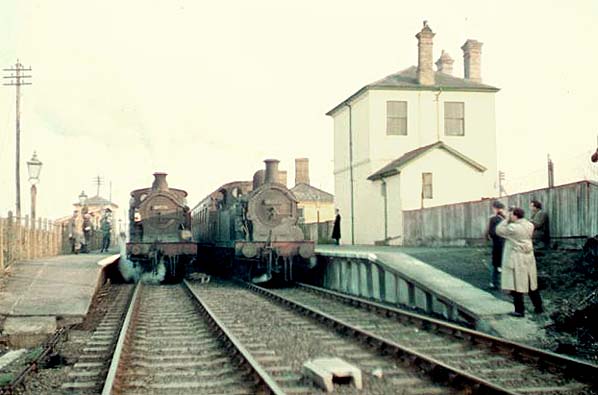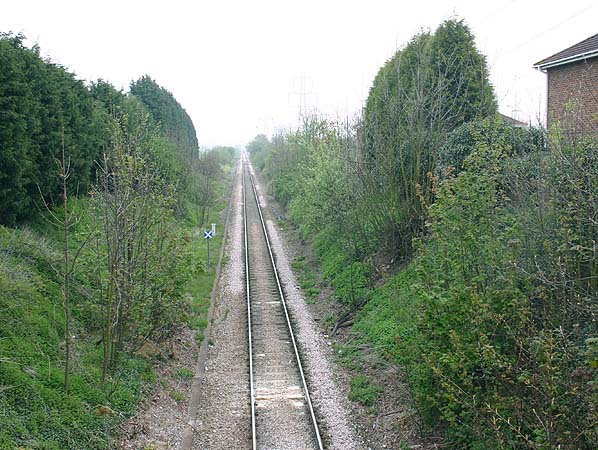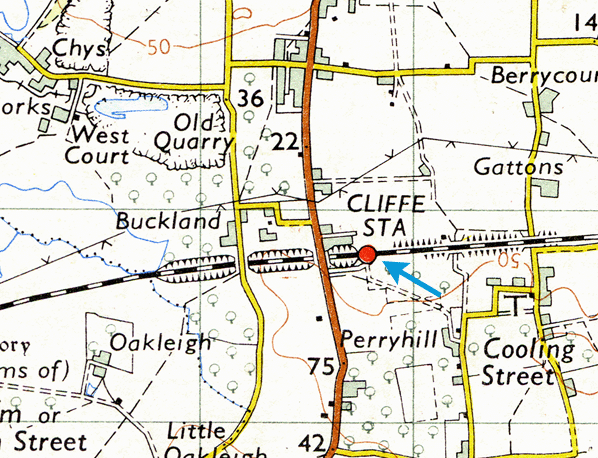|
Notes: Cliffe is the first of the original stations on the branch
and as built only had one platform, the second being added in
1935. It had a small goods yard, pricipally used by the local
fruit growers. Other traffic handled included milk and explosives
from Curtis and Harvey's gunpowder works at Cliffe.
BRIEF HISTORY OF THE HUNDRED OF
HOO RAILWAY
In 1865 the North Kent Extension Railway was granted authority
to build a line from the SER track at Gravesend across the marshes
to a pier on the west bank of the Medway opposite Sheerness. However
since neither of the rival companies, the LCDR nor the SER, liked
the idea, it failed to materialise.
Origins of the railway on the peninsula go back indirectly to
the Continental Trade Agreement whereby the LCDR and SER agreed
to share all receipts from Kent Coast and Continental traffic
in various proportions. In 1876 the LCDR violated the terms by
opening a railway pier at Queenborough with angered the SER who
immediately revived the scheme for a line from Gravesend to the
Medway and to achieve this end, they instigated a supposedly independent
company called the Hundred of Hoo Railway Company. As the route
from Charing Cross to Port Victoria (as it was to be called) was
40 miles compared to the LCDR's 52 mile route to Queenborough,
the SER were convinced the route would be successful.
Parliamentary Acts were granted by 1880 and construction work
started shortly afterwards. A further Act in 1881 passed the line
over to the SER. On April 1st 1882, the first section from Hoo
Junction to Sharnal Street was opened with the remaining section
to Port Victoria opening on September 11th 1882 by which time
a wooden pier and a modest weather-boarded Port Victoria Hotel
had been provided. It was soon clear that the new rout was not
as popular as predicted due to the new docks that opened at Tilbury
in 1886. The line was however used by the Royal Family.
Initially the Port Victoria branch had only two intermediate
stations at Cliffe and Sharnal Street but in 1906 new halts were
added to serve villages at High Halstow, Beluncle, Middle Stoke
and Grain Crossing. Between Cliffe and the junction with the Gravesend
to Higham line, a halt was provided near the British Uralite works
that had opened in 1901 and was used mainly by workmen's traffic.
Three further halts were also provided on the main line at Milton
Road, Denton and Milton Range. The halts were all of timber construction
but were later rebuilt in prefabricated concrete. Milton Road
was short lived and closed during WW1 as an economy measure. It
had never been popular due to its close proximity to Gravesend
Central and it never reopened.
By 1916 the pier at Port Victoria was declared unsafe and the
seaward portion was barricaded off.
Passenger traffic continued to dwindle after the First World
War but at the same time freight traffic was developing with the
opening of the Medway Oil and Storage (later Power Petroleum Company)
Company's new depot at Grain in 1928. The pier continued to deteriorate
and by 1931 no trains were allowed onto it and a temporary wooden
platform was built at the landward end while a basic concrete
platform was completed on safer ground.
The Southern Railway opened a single-track branch line from a
new station at Stoke Junction to Allhallows on Sea in 1932 optimistic
that a new resort would develop around the station. A station
hotel was built but the bleak marshes did not entice the holidaymakers.
Six trains a day were provided, two of these to and from London.
Allhallows-on-Sea station comprised an island platform with a
run-round loop plus carriage and goods sidings. Still hopeful,
the Southern Railway maintained its confidence in the lines future
with a second platform being added at Cliffe and Sharnal Street
and the branch to Allhallows was doubled in 1935.
With the opening of the branch to Allhallows, passenger traffic
to Port Victoria dwindled to almost nothing with only two trains
a day, principally for the benefit of the workers at the petrol
depot.
The popularity of Allhallows was improving by the late 1930's
and the Southern Railway considered doubling the whole line. The
proposal was put on hold on the outbreak of war in 1939 and was
eventually abandoned.
During the war the line was well used with the oil terminal being
adapted as the base for PLUTO (Pipeline under the Ocean) supplying
the allied forces in Europe.
After the war the long term future of freight traffic seemed
assured with the Anglo-Iranian Oil Company (the successor to Power
Petroleum) building their largest refinery in Britain at Grain
in 1948. Extensive rail facilities were provided and from June
19th 1951 Port Victoria (which was within the new refinery) and
Grain Crossing Halt were closed while a new Grain Station was
constructed 700 yards east of Grain Crossing. The new station
had a long single island platform and a large brick signal box
and was intended primarily for the use of workmen at the oil terminal.
Due to the increase of freight traffic there were rumours that
the whole line was to be electrified but the post war popularity
of the motor car led to a continued decline in passenger numbers.
The resort of Allhallows did not continue to develop and despite
all efforts, attempts to sell housing plots remained unsuccessful
and before long the railway authorities accepted defeat and reverted
to a limited local service. As the traffic continued to deteriorate
the line went back to single track in 1957.
The situation lingered on until 1961 when the passenger services
from Hoo Junction on the Gravesend line to Grain and the branch
to Allhallows were withdrawn on December 4th.
The wooden station buildings at Cliffe and Sharnal Street were
demolished in 1966 and the signal box at Cliff was demolished
in 1973.
In 1974 a campaign was instigated by Stoke Parish Council to
have the railway reopened to passenger traffic but British Rail
opposed the proposal as the line was only single traffic and because
of the signaling complications in introducing a passenger service
onto the busy freight line.
Sources:
Kent Railways Remembered by Leslie Oppitz - Countryside Books
1988 ISBN 1 85306 016 X
Isle of Grain Railways by Adrian Gray - Oakwood Press 1974
To see the other
stations on the Hundred of Hoo Railway Line click on the station
name: Milton Road
Halt, Denton Halt,
Milton Range Halt,
Uralite, High
Halstow Halt, Sharnal
Street, Beluncle
Halt, Middle
Stoke Halt,
Stoke
Junction Halt, Grain
Crossing Halt, Grain,
Port Victoria
& Allhallows-on-Sea.
|




 Home Page
Home Page 











